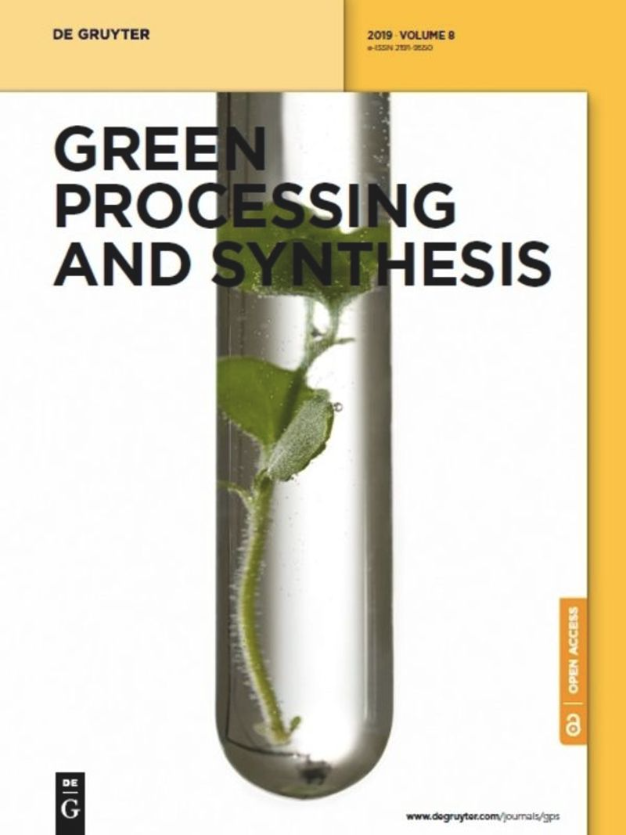Recyclability and catalytic characteristics of copper oxide nanoparticles derived from bougainvillea plant flower extract for biomedical application
IF 3
4区 工程技术
Q2 CHEMISTRY, MULTIDISCIPLINARY
引用次数: 1
Abstract
Abstract This work aims to investigate the environmentally sustainable technique to synthesize the copper nanoparticles using bougainvillea flower ethanolic extract at ambient temperature. Copper nanoparticles have considerable potential for reducing the environment’s harmful pigments and nitrogen contaminants. The oxidized copper nanoscale catalysts are enclosed inside nanomaterial, which work as a benign and sustainable resource for capping agents. Ultraviolet spectroscopic, transmission electron microscopy (TEM), and X-ray crystallography (XRD) techniques were used to evaluate the produced oxidized copper nanocrystals. The particles produced have been very robust, are cylindrical in form, and have an outer diameter of 12 nm. Furthermore, under normal conditions, copper oxide (CuO) nanomaterials demonstrated strong photocatalytic efficiency in liquid media for the oxidation of Congo red, bromothymol blue, and 4-nitrophenol in an acidic solution acetic anhydride. Moreover, the CuO nanocrystalline enzyme could be readily vortexed or used for five cycles with an exchange rate of even over 90%. The evaporation process caused around 18% of the loss of weight between 25°C and 190°C, while soil organic breakdown caused almost 31% of the loss of weight around 700°C. As a result, the little reduction in enzymatic effectiveness of the recoverable multilayer CuO substrate might be attributed to catalytic degradation throughout spinning and processing.九重葛植物花提取物氧化铜纳米颗粒的可回收性及催化特性
摘要:本研究旨在研究以九重葛花乙醇提取物为原料,在室温下合成铜纳米颗粒的环境可持续性技术。铜纳米颗粒在减少环境中的有害色素和氮污染物方面具有相当大的潜力。氧化铜纳米级催化剂被包裹在纳米材料中,是一种良性的、可持续的封盖剂资源。采用紫外光谱、透射电子显微镜(TEM)和x射线晶体学(XRD)技术对制备的氧化铜纳米晶体进行了表征。所产生的颗粒非常坚固,呈圆柱形,外径为12纳米。此外,在正常条件下,氧化铜(CuO)纳米材料在液体介质中对刚果红、溴百里香酚蓝和4-硝基酚在醋酸酐酸性溶液中的氧化表现出很强的光催化效率。此外,氧化铜纳米晶酶可以很容易地涡流或使用5个循环,交换率甚至超过90%。在25°C至190°C之间,蒸发过程造成了约18%的重量损失,而在700°C左右,土壤有机分解造成了近31%的重量损失。结果表明,可回收多层CuO底物的酶效率降低可能是由于纺丝和加工过程中的催化降解。
本文章由计算机程序翻译,如有差异,请以英文原文为准。
求助全文
约1分钟内获得全文
求助全文
来源期刊

Green Processing and Synthesis
CHEMISTRY, MULTIDISCIPLINARY-ENGINEERING, CHEMICAL
CiteScore
6.70
自引率
9.30%
发文量
78
审稿时长
7 weeks
期刊介绍:
Green Processing and Synthesis is a bimonthly, peer-reviewed journal that provides up-to-date research both on fundamental as well as applied aspects of innovative green process development and chemical synthesis, giving an appropriate share to industrial views. The contributions are cutting edge, high-impact, authoritative, and provide both pros and cons of potential technologies. Green Processing and Synthesis provides a platform for scientists and engineers, especially chemists and chemical engineers, but is also open for interdisciplinary research from other areas such as physics, materials science, or catalysis.
 求助内容:
求助内容: 应助结果提醒方式:
应助结果提醒方式:


